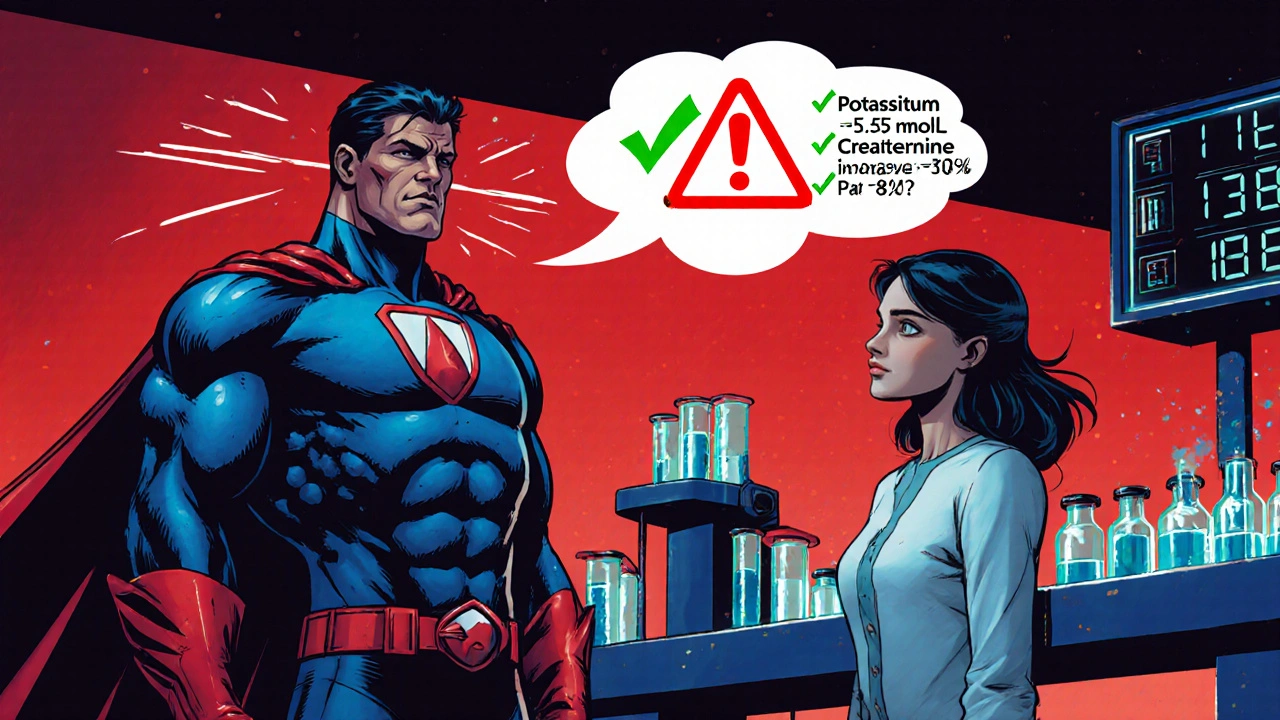Telmisartan Dosage Calculator
Personalized Dosage Calculator
Get your recommended Telmisartan dose based on your medical condition, age, and kidney function
When doctors prescribe a pill to lower blood pressure, Telmisartan often tops the list. This guide breaks down exactly what the drug does, who should take it, how to dose it safely, and what to watch out for.
What Is Telmisartan?
Telmisartan is an Angiotensin II Receptor Blocker (commonly called an ARB) that relaxes blood vessels by blocking the hormone angiotensin II. The result is lower blood pressure and less strain on the heart.
How Telmisartan Works in the Body
Angiotensin II normally binds to AT1 receptors on blood‑vessel walls, causing them to tighten. Telmisartan sits on those receptors, preventing the hormone from attaching. By keeping the vessels dilated, it reduces the force the heart must pump against - a simple but powerful effect.
Approved Medical Uses
Besides the headline indication of Hypertension, Telmisartan is also used for:
- Reducing the risk of major cardiovascular events in patients with Cardiovascular disease (e.g., after a heart attack).
- Slowing the progression of kidney damage in people with type 2 diabetes - a benefit known as Renal protection.
- Managing heart failure when other therapies are insufficient.
Standard Dosage Guidelines
Dosage depends on the condition, age, and kidney function. Below is a quick reference:
- Hypertension (adults): Start with 40mg once daily. If blood pressure is not at target after 2‑4 weeks, increase to 80mg. Some patients may require up to 120mg.
- Cardiovascular risk reduction: 80mg daily is typical, regardless of baseline pressure.
- Diabetic nephropathy: Begin at 40mg; most clinicians keep patients on 80mg for the renal benefit.
- Elderly or impaired renal function: Do not exceed 80mg; start low and go slow.
All doses are taken as a single tablet, preferably at the same time each day. The medication can be swallowed with or without food - no special timing is needed.
Special Populations
For patients younger than 18years, Telmisartan is not approved; pediatric dosing remains off‑label and should be managed by a specialist. Pregnant women must avoid ARBs entirely because they can harm the developing fetus.
Side Effects & Safety Profile
Most people tolerate Telmisartan well. Common, mild issues (<5% incidence) include:
- Dizziness, especially when standing up quickly.
- Headache.
- Upper‑respiratory infections.
Serious but rare reactions (less than 1%):
- High potassium levels (hyperkalaemia), which can affect heart rhythm.
- Kidney function decline - monitor serum creatinine after starting therapy.
- Angio‑edema (swelling of lips, tongue, or throat) - seek emergency care if it occurs.
Contraindications & Drug Interactions
Do not start Telmisartan if you have:
- Known hypersensitivity to Telmisartan or any ARB.
- Severe liver disease (the drug’s metabolism is hepatic).
- Pregnancy or planning to become pregnant.
Key interactions to watch for:
- Potassium‑sparing diuretics, supplements, or high‑potassium foods - risk of hyperkalaemia.
- NSAIDs (e.g., ibuprofen) - may blunt blood‑pressure lowering and harm kidneys.
- Lithium - increased lithium levels can cause toxicity.
Pharmacokinetics Snapshot
Telmisartan has a long half‑life of about 24hours, which is why once‑daily dosing works. It is highly protein‑bound (≈99.5%) and excreted mainly via the bile. Peak plasma concentrations occur 0.5‑2hours after ingestion.

Monitoring and Follow‑Up
When you start Telmisartan, schedule labs within 1‑2 weeks:
- Blood pressure - aim for < 130/80mmHg in most patients.
- Serum potassium - keep <5.5mmol/L.
- Serum creatinine - an increase of >30% signals a problem.
After stability is achieved, annual checks are usually enough unless you develop new health issues.
Comparing Telmisartan with Other ARBs
| Drug | Typical Daily Dose | Half‑Life | Renal Benefit |
|---|---|---|---|
| Telmisartan | 40‑120mg | ~24h | Strong - slows diabetic nephropathy |
| Losartan | 50‑100mg | ~2h (active metabolite 6‑9h) | Moderate |
| Valsartan | 80‑320mg | ~6h | Limited data |
| Olmesartan | 20‑40mg | ~13h | Moderate |
Practical Tips for Patients
- Take the tablet with a full glass of water; you don’t need food.
- If you miss a dose, take it as soon as you remember unless it’s almost time for the next one - then skip the missed dose.
- Avoid excessive salt and high‑potassium foods (bananas, oranges, tomatoes) if you’re on a potassium‑sparing diuretic.
- Report any sudden swelling of the face, lips, or throat immediately.
- Keep a log of blood‑pressure readings to show your doctor at each visit.
Frequently Asked Questions
Can I take Telmisartan with my blood‑pressure pill?
Telmisartan itself is a blood‑pressure pill. If your doctor prescribes another antihypertensive (e.g., a calcium‑channel blocker), they have usually considered the interaction. Never add a second ARB without medical advice.
How long does it take to see a blood‑pressure drop?
Most patients notice a modest reduction within a few days, but the full effect may take 2‑4 weeks as the body adjusts.
Is Telmisartan safe for people with early kidney disease?
Yes, in fact the drug is often chosen for its protective effect on the kidneys. Your doctor will monitor creatinine and potassium levels regularly.
What should I do if I develop a rash?
A mild rash can be a harmless allergy, but stop the medication and call your healthcare provider. If the rash spreads quickly or is accompanied by swelling, seek emergency care.
Can I travel abroad while on Telmisartan?
Absolutely. Keep the medication in its original packaging, carry a copy of your prescription, and stay hydrated, especially on long flights.

Sriram K
October 13, 2025
Telmisartan works by blocking the AT1 receptor, which helps keep your blood vessels relaxed. For most adults with hypertension, starting at 40 mg once daily is typical, and the dose can be titrated up to 80 mg after a few weeks if needed. Patients with cardiovascular risk often stay on 80 mg, while those with diabetic kidney disease may benefit from a consistent 80 mg dose for renal protection. Elderly individuals or anyone with reduced kidney function should not exceed 80 mg and should begin at the lower end of the range. Always take the tablet at the same time each day, with or without food, and keep your doctor informed about any side effects.
Deborah Summerfelt
October 22, 2025
So you think a pill that blocks a hormone is just a magic bullet? Nah, the body’s a messy system and pulling one lever can shift other gears. Take it with a grain of salt and watch how your pressure actually behaves, not just the label.